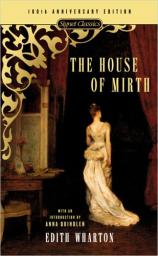The House of Mirth
About the Book
The House of Mirth
The House of Mirth, published in 1905, marks Edith Wharton's emergence as one of America's greatest writers. Although Wharton had previously published two collections of stories, The Greater Inclination (1899) and Crucial Incidents (1901) and the novel The Valley of Decision (1902), her decision to write about fashionable New York, a world she "had been steeped in since infancy," brought her immediate success and recognition. As she wrote in her autobiography, A Backward Glance (1934), her goal in The House of Mirth was to uncover the true nature of society's power and to answer the question: "in what aspect could a society of irresponsible pleasure-seekers be said to have, on the 'old woe of the world,' any deeper bearing that the people composing such a society could guess?"
By 1905, the genteel milieu of Wharton's childhood was rapidly disappearing. Fashions—and economics—had changed, and Old New York society was forced to recognize the power of "new money" and even to accept the newly rich, with their tremendous wealth earned in a suspect marketplace, into their circle. It was a concession that would not only corrode their sense of style and decorum, but allow them to sacrifice the members of the "old" society who could not keep pace. Lily Bart, the heroine of The House of Mirth, is a victim of a large, unstoppable shift in the ways of the world.
Launched into society at a glorious and very expensive debutante ball, Lily sees a world of unlimited possibility before her. But her father's announcement that he is financially ruined, followed quickly by his death, leave Lily and her mother with only one "asset"—Lily's extraordinary beauty and charm. At the age of 29, now orphaned, Lily lives with an aunt who offers minimum, often grudging, hospitality and financial support. A wealthy husband could satisfy her craving for luxury and admiration, but Lily is reluctant to consummate this kind of "deal." In a chronicle that richly details the follies of shallowness, and cruelties of society as it illuminates Lily's own ambivalence about who and what she wants, Wharton traces her heroine's decline from her elite position as a much-desired guest in exclusive social events, to her role as a liaison between rich "outsiders" eager to be accepted in society but ignorant of its ways, to her piteous existence when the homes of both old and new society are firmly, finally, closed to her.
On one level a devastating satire of a world devoid of moral scruples, The House of Mirth is also a stringent critique of the particular restrictions and limitations such a world imposes on women. Lily is a woman not only of charm, but of intelligence; her outward beauty matched by a genuine, if undeveloped, appreciation of art and of nature's beauty. By succumbing to society's definition of her as a beautiful object and nothing more, however, Lily in many ways authors her own fate. Woven throughout the novel are threads of Wharton's own experience. Born in 1862, Wharton spent her childhood in the staid brownstones of New York and the elegant country houses to which the rich retired during the summer, and was intimately acquainted with the styles of entertaining, of dress, and of conspicuous consumption favored by the people who inhabited them. She married five years after her own debut, late enough to have contemplated the likely fate of an unmarried woman in the latter part of the nineteenth century. Though her husband, Edward, was well-enough off to avoid working in the despised business world, the two were fundamentally incompatible. Edward admired Edith's brilliance, but he was far from her intellectual equal and shared few of her interests. The critic Edmund Wilson speculated that Wharton turned to fiction to ease the tensions of her marriage; certainly the world she created through her writing must have been a welcome haven from the tedium and disappointments of life with Edward. But it is the very act of writing that separates Wharton from her fictional creation. Unlike Lily, Wharton took an active role in defining herself, becoming a masterful writer, and establishing that a woman need not depend on others to achieve dignity and a sense of worth. The world is much richer for it.
The House of Mirth
- Publication Date: February 1, 2000
- Mass Market Paperback: 350 pages
- Publisher: Signet Classics
- ISBN-10: 0451527569
- ISBN-13: 9780451527561









